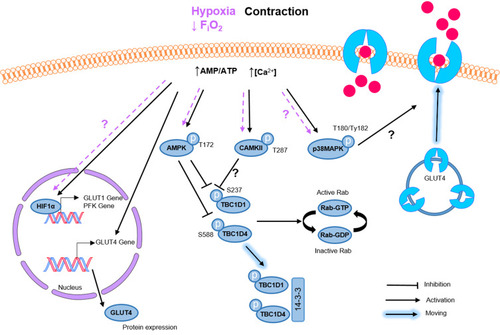Figures & data
Table 1 Design and Main Results from the Studies Investigating the Effects of a Single Exercise or Exercise Training in Hypoxia vs Normoxia in Subjects at Risk of Developing Diabetes
Figure 1 Regulation of glucose transport by exercise and hypoxia in human skeletal muscle. Proposed model for the underlying mechanisms mediating exercise- and hypoxia-induced skeletal muscle GLUT4 translocation. FiO2, inspired oxygen fraction; AMP/ATP, adenosine monophosphate/adenosine triphosphate; AMPK, AMP-activated protein kinase; TBC1D1, Tre-2/BUB2/cdc 1 domain family 1; TBC1D4, Tre-2/BUB2/cdc 1 domain family 4; CaMKII, Ca2+/calmodulin-dependent protein kinase II; p38MAPK, p38 mitogen-activated protein kinase; GLUT4, glucose transporter 4; HIF1α, hypoxia-inducible factor 1 alpha; PFK, phosphofructokinase; GLUT1, glucose transporter 1; Rab-GDP, guanosine-diphosphate Rab; Rab-GTP, guanosine-triphosphate Rab. Filled arrows represent exercise signaling and dotted arrows represent hypoxia signaling; ?Indicate probable but not proven pathways.

